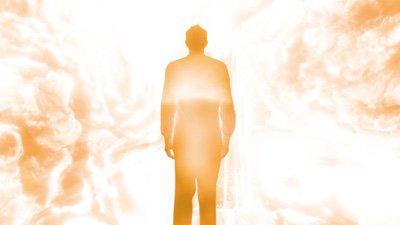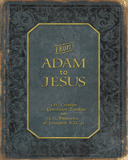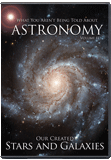God of Heaven and Earth—A (New?) Film Review
Another flawed Star of Bethlehem presentation
The trailer for God of Heaven and Earth invites viewers “to journey with Rick Larson and see with your own eyes the mysteries and wonders God left for the world to discover” in relation to the birth, death, and resurrection of Jesus. Those who went to the theaters hoping to see evidence of these mysteries and wonders were likely somewhat disappointed by what they saw. I traveled to a local theater on November 6 to see what Frederick (Rick) A. Larson would reveal.
The trailer promised evidence for the resurrection of Jesus, but this subject was only indirectly addressed.
The trailer was rather misleading in at least two ways. First, it made it seem as if viewers would see an entirely new film. However, the first two-thirds of the film was simply a reshowing of Larson’s The Star of Bethlehem DVD from 2007. The trailer didn’t give any indication of this, so people who had already seen this presentation might feel as if a bait and switch had occurred in the marketing of the film. Furthermore, a DVD-quality presentation does not look very good on the big screen, so it is rather jarring when the final third of the film consists of newer high-resolution footage. Second, the trailer promised evidence for the resurrection of Jesus, but this subject was only indirectly addressed.1
Besides the problems with the film not living up to the trailer’s promises, was the film worth watching? Before answering that question, let’s consider the strengths and weaknesses of the film’s content, and we’ll begin with the weaknesses.
The Star of Bethlehem
The first hour or so was basically Larson’s The Star of Bethlehem presentation. For those unfamiliar with this video, Larson gained some popularity when this DVD was released. Using “Starry Night” software, Larson showed viewers what the night sky would presumably have looked like from Babylon and Jerusalem at the times he believes are relevant to the birth of Jesus Christ. AiG’s astronomer, Dr. Danny Faulkner, wrote a detailed critique of this presentation many years ago. After highlighting some of the problems with Larson’s claims, Faulkner concluded the following:
Larson’s thesis is fraught with problems. It completely relies upon the late death of Herod, something that few historians have embraced. It has some obvious astrological connections that we have not discussed in any detail here. These astrological connections are related to the so-called gospel in the stars theory, which is without foundation, and I have discussed elsewhere.
Dr. Faulkner mentioned the late date for the death of Herod the Great, the king at the time of Jesus’ birth. There has been considerable debate over the timing of Herod’s death, and the many issues involved are too complex to address here. The traditional date of 4 BC has been widely accepted by scholars, such as Emil Schurer and Harold Hoehner. More recently, some scholars, such as Jack Finegan and Andrew Steinmann, have opted for a date of around 1 BC for Herod’s death. If the traditional date of 4 BC is accurate, Larson’s view is falsified.
Even if the nontraditional date could be established as accurate, it would not confirm the rest of Larson’s presentation. Perhaps the greatest problem with his view of the star is that planetary alignments and conjunctions between planets and stars do not follow the behavior of the star in Matthew 2. It seems best to understand the “star” as being a unique and miraculous sign from the Lord to guide the magi to the house where Jesus and his parents were staying.
Knowing that much of Larson’s material echoed the ideas promoted by Ernest L. Martin gave me plenty of reasons to question its veracity. Martin is largely responsible for starting a movement that claims the Jewish temples were in the City of David rather than on the Temple Mount. I have written two articles refuting the many false claims made by Martin and others who promote this idea. Martin and others often play fast and loose with the biblical and historical details. Thus, it was not surprising to see Larson use the same practices here. For example, Larson stated that from Jerusalem on December 25, 2 BC, Jupiter would have appeared as though it had stopped over Bethlehem in the southern sky. He explains that this stopping is due to retrograde motion. However, the “Starry Night” program he relies upon shows that Jupiter was still moving and would not “stop” (begin its apparent backward motion) until 2–3 days later.2 To read about more of the problems with Larson’s “star” and how it does not align with biblical details, please read Dr. Faulkner’s full critique, linked above.
The Crucifixion Earthquake and the Dead Sea
The final 30 minutes of the film focused on locating evidence consistent with the events that occurred at the time of Jesus’ death, as recorded in Matthew 27. To do this, Larson traveled to the shore of the Dead Sea to study the varves that have been formed over the years. Because of its unique conditions, including the lack of living creatures, the Dead Sea offers a unique research opportunity. Each year, a fine laminate (varve) forms on the sea’s floor. Since the Dead Sea has been drying up, the ancient shoreline is accessible to researchers, allowing them to study these varves.
Of particular interest is the way in which these layers are disturbed whenever a significant earthquake occurs in the region. When the ground in the area shakes, the water is disturbed, and it wildly distorts the top layer of sediment on the seafloor, creating a layer known as a seismite. Thus, researchers can use these varves to see whether they match the historical records about earthquakes in the region. Josephus reported that during the Battle of Actium (31 BC), there was an earthquake in Judea that killed 10,000 people.3 The record of this great earthquake has been located in the Dead Sea laminates and confirmed by radiocarbon dating of biotic material found in the layer.
In the film, Revital Bookman, one of the scholars leading the research on these varves, showed Larson another seismite 13 inches above the one representing the quake from 31 BC. This one just happens to be precisely where one would expect to find evidence from another earthquake known from a historical source—the Gospel of Matthew.
And behold, the curtain of the temple was torn in two, from top to bottom. And the earth shook, and the rocks were split. (Matthew 27:51)
As with so many other events in the Bible, skeptics have challenged the historicity of the details in this passage, claiming that Matthew invented or embellished details to make the death of Jesus seem more important. Yet, once again, scientists have discovered evidence that confirms the biblical account. The Bible states that an earthquake occurred at the time of Christ’s crucifixion, and the varves from the Dead Sea area confirm that an earthquake did indeed occur in the region at that time.
While Larson cites this as proof that Jesus was crucified in AD 33 on April 3, the laminate record cannot be this precise. The researchers who published the research article stated that the earthquake occurred in AD 31 +/- 5 years.4 In other words, it is not possible to pinpoint an exact date based on the layers. Nevertheless, the evidence for an earthquake in the region between AD 26–36 encompasses the two most popular dates for Christ’s crucifixion (AD 30 and 33).
Conclusion
In his conclusion, he overstates his case by implying that the seismite dates to exactly AD 33.
While introducing some interesting ideas, Larson often misrepresents the data to build his case for the so-called Christmas star. For a better understanding of this event, I would recommend that guests check out The Christmas Star, the Creation Museum’s planetarium show that runs every year during the Christmas season. When it comes to the Dead Sea layers, Larson does a good job of presenting the material, allowing viewers to see the layers for themselves as he is guided by an expert. Nevertheless, in his conclusion, he overstates his case by implying that the seismite dates to exactly AD 33.
Overall, I would recommend the final third of the film, as it documents fascinating evidence consistent with the biblical record. Concerning the first two-thirds of the movie, I would only recommend it for those who are already well-versed in the subject and are willing to compare everything with Scripture. When that is done, one will see that Larson is merely peddling an idea that is not consistent with the biblical data about the Christmas “star.”
Footnotes
- Regarding the resurrection of Jesus, the end of the film featured a glimpse of the resurrected Savior preparing to leave the tomb. Also, while discussing evidence from the Dead Sea for earthquakes in the region (see the second half of this review), the film focused on the quake that occurred at the time of the Lord’s death on the cross (Matthew 27:51), but there was another quake during the same time period. Matthew 28:2 states that “there was a great earthquake” around the time the angel rolled the stone away from the tomb. So which one is reflected in the varves at the Dead Sea? Well, there would not have been enough time after the first quake for the sediments to resettle before the second quake disturbed them again. So it is unlikely that the sediments would show a distinction between the two events, but they do show that at least one earthquake occurred in that time period.
- Colin Nicholl, “What IS Wrong with Rick Larson’s ‘Star of Bethlehem’ DVD Documentary,” New Testament, Union, accessed November 8, 2023, https://www.uniontheology.org/resources/bible/new-testament/what-is-wrong-with-rick-larsons-star-of-bethlehem-dvd-documentary.
- Josephus, Antiquities of the Jews, XV 5.2. The number of dead contradicts Josephus’ other mention of this earthquake in which he states that 30,000 men were killed. Josephus, Wars of the Jews, I.19.3.
- Biblical Archaeology Society Staff, “Is Jesus’ Crucifixion Reflected in Soil Deposition?” Bible History Daily, Biblical Archaeology Society, August 18, 2022, https://www.biblicalarchaeology.org/daily/biblical-topics/crucifixion/jesus-crucifixion-reflected-in-soil-deposition/.
Recommended Resources

Answers in Genesis is an apologetics ministry, dedicated to helping Christians defend their faith and proclaim the good news of Jesus Christ.
- Customer Service 800.778.3390
- © 2024 Answers in Genesis







